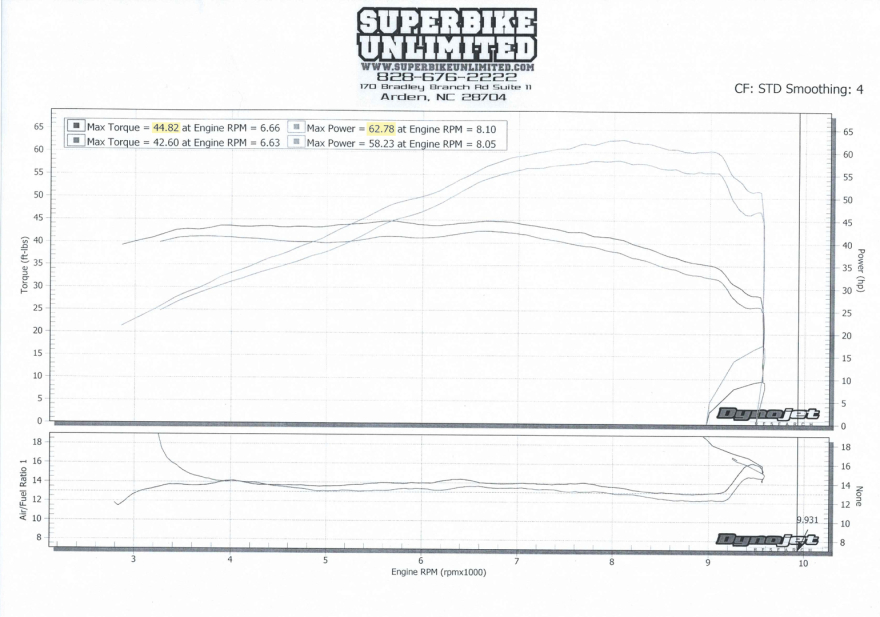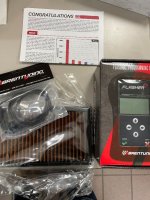CO2 regulations haven't been applied to motorcycles (yet). Fuel consumption isn't a consideration.
One of the consequences of "dieselgate" is that there is increasing focus on "real driving emissions". It used to be that if you passed the official test procedure, you were good to go. Then came the VW (and other) diesel shenanigans. Then came "real driving emissions". All gasoline engines historically, and particularly highly tuned engines, run rich under load. The "real driving emissions" means the emission strategy has to function over a much bigger operating range. Means leaning it out so that the catalyst still functions. Not a recipe for making max power. I don't know how much this plays into the motorcycle Euro 5 standard, but it's certainly a factor in automotive emission standards.
If the catalyst is far enough down the exhaust pipe to not overheat at full load, it might need help at light-load part-throttle cruise to keep it hot enough to work. There are certain strategies used for keeping catalysts hot that aren't great for fuel consumption.
You know the much discussed "deceleration fuel cut"? What happens to the catalyst when you're coasting down a hill? It cools off. Then what happens when you take up the throttle again? A puff of untreated exhaust (complete with CO, HC, and NOx) until the catalyst gets back up to the right temperature. So, what does the OEM do? Squirts in a little bit of fuel anyhow, to keep the catalyst hot ...
A lot of those emission test procedures are done at very light engine load on a high-performance vehicle. When you have a 200 hp bike and you have a test procedure that is the same for all vehicles including a 900cc Fiat Panda non-turbo, that engine will do the whole test making no more than 10 horsepower. Not good for keeping the catalyst hot. So, what do you do? Delay the ignition timing to raise the exhaust temperature. Bye-bye fuel economy.
Redesigning the engine to cope with this without bad fuel consumption is possible (auto engines have done it) but not necessarily while maintaining absolute maximum possible power output per litre of displacement.
One of the consequences of "dieselgate" is that there is increasing focus on "real driving emissions". It used to be that if you passed the official test procedure, you were good to go. Then came the VW (and other) diesel shenanigans. Then came "real driving emissions". All gasoline engines historically, and particularly highly tuned engines, run rich under load. The "real driving emissions" means the emission strategy has to function over a much bigger operating range. Means leaning it out so that the catalyst still functions. Not a recipe for making max power. I don't know how much this plays into the motorcycle Euro 5 standard, but it's certainly a factor in automotive emission standards.
If the catalyst is far enough down the exhaust pipe to not overheat at full load, it might need help at light-load part-throttle cruise to keep it hot enough to work. There are certain strategies used for keeping catalysts hot that aren't great for fuel consumption.
You know the much discussed "deceleration fuel cut"? What happens to the catalyst when you're coasting down a hill? It cools off. Then what happens when you take up the throttle again? A puff of untreated exhaust (complete with CO, HC, and NOx) until the catalyst gets back up to the right temperature. So, what does the OEM do? Squirts in a little bit of fuel anyhow, to keep the catalyst hot ...
A lot of those emission test procedures are done at very light engine load on a high-performance vehicle. When you have a 200 hp bike and you have a test procedure that is the same for all vehicles including a 900cc Fiat Panda non-turbo, that engine will do the whole test making no more than 10 horsepower. Not good for keeping the catalyst hot. So, what do you do? Delay the ignition timing to raise the exhaust temperature. Bye-bye fuel economy.
Redesigning the engine to cope with this without bad fuel consumption is possible (auto engines have done it) but not necessarily while maintaining absolute maximum possible power output per litre of displacement.


















